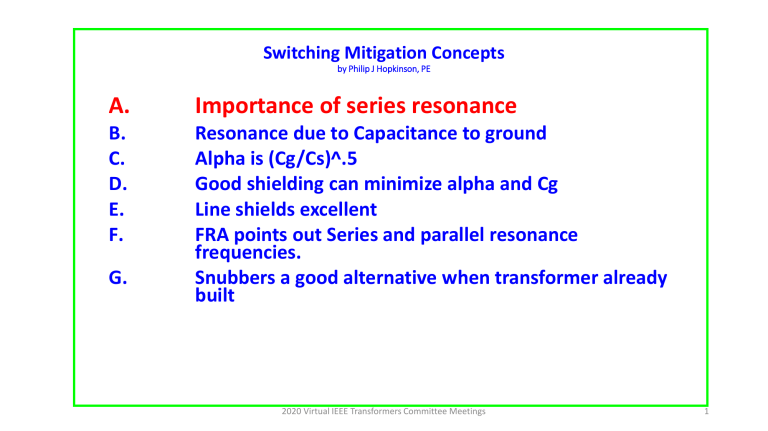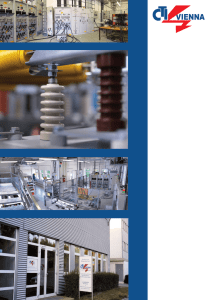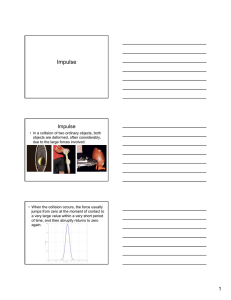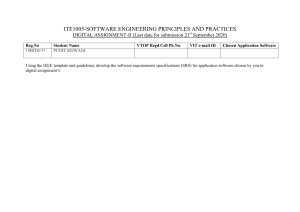
Switching Mitigation Concepts by Philip J Hopkinson, PE A. Importance of series resonance B. C. D. E. F. Resonance due to Capacitance to ground Alpha is (Cg/Cs)^.5 Good shielding can minimize alpha and Cg Line shields excellent FRA points out Series and parallel resonance frequencies. Snubbers a good alternative when transformer already built G. 2020 Virtual IEEE Transformers Committee Meetings 1 Switching Mitigation Concepts by Philip J Hopkinson, PE A. Importance of series resonance Inductor, L + Capacitor, C 1. Parallel impedance infinity at resonance. No problem 2. Series impedance zero at resonance, a. b. c. Current Very high Voltage high across L and C Terminal voltage zero at resonance V l (+) V c (-) 3. Damping could solve problem 4. Cleaver shielding can also solve problem 2020 Virtual IEEE Transformers Committee Meetings 2 Switching Mitigation Concepts by Philip J Hopkinson, PE 1. Cs is series capacitance 2. Cg is capacitance to ground 3. Alpha (α) = (Cg/Cs)^0.5 4. If Cg and α =0 then no series resonance Note, graphics from Blume, chapter 17 figure 2 on Transient Voltage Characteristics 2020 Virtual IEEE Transformers Committee Meetings 3 Switching Mitigation Concepts by Philip J Hopkinson, PE 1. Typical initial surge distribution 2. When α = 0. impulse linear 3. Alpha (α) = (Cg/Cs)^0.5 4. If Cg and α =0 then no series resonance Note, graphics from Blume, chapter 17 figures 6 and 7 on Transient Voltage Characteristics 2020 Virtual IEEE Transformers Committee Meetings 4 Switching Mitigation Concepts by Philip J Hopkinson, PE 1. Typical initial surge distribution followed by envelope of oscillations 2. When α = 0. impulse linear 3. Alpha (α) = (Cg/Cs)^0.5 4. If Cg and α =0 then no series resonance. Note, graphics from Blume, chapter 17 figure 2 on Transient Voltage Characteristics 2020 Virtual IEEE Transformers Committee Meetings 5 Switching Mitigation Concepts by Philip J Hopkinson, PE 1. Shielding for disk windings with static rings increases Cs 2. Greater shielding on the right improves disk winding impulse behavior 3. Resonance can be reduced through improved shielding. Note, graphics from Blume, chapter 17 figures 12, 13, and 15 on Transient Voltage Characteristics 2020 Virtual IEEE Transformers Committee Meetings 6 Switching Mitigation Concepts by Philip J Hopkinson, PE 1. Shielding for Layer windings increases Cs and greatly reduces Cg 2. Winding turns at start and finish see line shields and not ground 3. Easiest winding to minimize series resonances Note, graphics from Blume, chapter 17 figure 14 on Transient Voltage Characteristics 2020 Virtual IEEE Transformers Committee Meetings 7 Remember the Data Center from 2007 2007 IEEE Seminar in Minneapolis on Data Center PJ Hopkinson, PE, R Degeneff, N McQuin Data Center Breaker Cable Transformer Inductive Load Low Power Factor Current Chops & Breaker reignitions 2020 Virtual IEEE Transformers Committee Meetings 8 Recorded waves at Data Center and non-shielded windings by Philip J Hopkinson, PE Data Center Line to ground voltage measurement with 15 kV switchingopening on ac system—Snubbers or shielding needed Current Chops & Breaker reignitions make 700 kHZ Two dominant frequencies: 45 kHz and 700 kHz 2020 Virtual IEEE Transformers Committee Meetings 9 Impulse Test concepts by Philip J Hopkinson, PE Winding had 16 disk-disk flashovers but passed 150 kV BIL impulse back at factory! 2020 Virtual IEEE Transformers Committee Meetings 10 Impulse Test Concepts Transformer Switching-A Current Update:Part 1 PJ Hopkinson, PE, R Degeneff, N McQuin Data Center Line-Gnd Voltage during Breaker opening with snubbers in place- note absence of high frequency transients Current Chops & Breaker reignitions make 700 kHZ 2020 Virtual IEEE Transformers Committee Meetings 11 Impulse Test concepts by Philip J Hopkinson, PE AEP experience at 765 kV 1. 2. 3. 4. 5. 6. 7. 8. Early experience had 25 field failures out of 100 transformers in 1980’s Improved shielding added to windings. Test levels too low BIL raised from 1800 kV BIL to 2050 kV BIL Switching Surge increased to 1700 kV Induce increased to 2.0 XN Enhanced and 1.8 XN for 1 hour. Chop wave at 2255 kV more severe than FFSI. No failures after new tests. Two Tests especially important: 1. Fast Front Switching Impulse 2. Special Termination Lightning Impulse 2020 Virtual IEEE Transformers Committee Meetings 12 Impulse Test concepts by Philip J Hopkinson, PE Apparent upgrades that have worked in the field 1. 2. 3. 4. Extensive inter-shielding of disk type windings. Add line shields to layer windings. R-C snubbers to provide over-damping. Add multiple groups of part-winding arresters Robustness achieved either by: 1. Improving ratio of (winding series capacitance divided by capacitance to ground) 2. Adding damping to the circuit 3. Finding ways to clip internal voltages 2020 Virtual IEEE Transformers Committee Meetings 13 Impulse Test concepts by Philip J Hopkinson, PE Natural frequencies show resonance for LV Shorted and Open 2020 Virtual IEEE Transformers Committee Meetings 14 Impulse Test concepts by Philip J Hopkinson, PE SFRA determination of transformer Natural Frequencies are clues but not directly relatable to field performance 1. Circuits in the field are more complex than in the factory 2. Field circuits may enhance certain natural frequencies. a. Cable lengths may further reinforce natural frequency response b. Harmonic filters and other devices may also be in tune 4. Current chops and restrikes of breakers may excite resonances. 5. Lack of any real load makes for a dangerous combination. Strong clues to Field Problems: 1. Highly oscillatory windings to impulse and chop wave tests 2. Low power factor circuits at the point of switching 3. Lack of damping in the circuit 2020 Virtual IEEE Transformers Committee Meetings 15 Impulse Test concepts by Philip J Hopkinson, PE Ideal Impulse Test 1. 2. 2. 3. 4. Fast rising wave. Significant hold time Severe chop wave. Includes test with shorted terminals of untested windings Includes test with open terminals of untested windings but protected with arresters. Good impulse Test : 1. Higher line terminal voltage than can occur in the field 2. Able to excite all natural frequencies of the windings 2020 Virtual IEEE Transformers Committee Meetings 16 Impulse Test concepts by Philip J Hopkinson, PE AEP success at 765 kV attributed to: 1. 2. 3. 4. 5. 6. Raising BIL from 1800 kV to 2050 kV, or +14%. Raising cop wave to 2255 kV from 1980 kV. or +14% Switching impulse rise time decreased from 100 μ sec. to 1.2 μ sec. Switching Impulse time to first 0 increased from 1000 μ sec. to 4200 μ sec. Includes test with shorted terminals of untested windings Includes test with open terminals of untested windings or protected with arresters. 2020 Virtual IEEE Transformers Committee Meetings 17 Impulse Test concepts by Philip J Hopkinson, PE Conclusions: Transformer design to withstand switching must add strength 1. Greater linearity of impulse wave distribution. 2. Greater attenuation of high frequency energy 3. Less susceptibility to internal series resonances Conclusions: Impulse Testing must add stress 1. 2. 3. 4. 5. Higher BIL levels Faster front waves Higher chop waves Longer switching waves Open as well as shorted terminals of non-tested windings 2020 Virtual IEEE Transformers Committee Meetings 18




